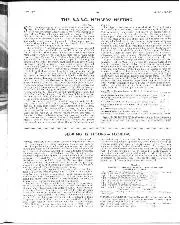
Sebring 12 Hours – Florida
March 27th The organisers of the annual American long-distance classic made themselves rather unpopular with certain parts of Europe, by allowing unlimited capacity sports cars into the race that is…
SPORTING MACHINES ON TEST.
The 25() c.c. o.h.v. New Imperial.
ALTHOUGH there are several smaller sporting machines on the market to-day, some of them distinctly fast, the 250 c.c. engine is really the smallest size that receives any measure of support from the sporting and racing fraternity in this country. Apart from machines fitted with one or other of the proprietary engines, the New Imperial is practically the only o.h.v. four-stroke of this size, and as such commands considerable interest and popularity.
The machine reviewed is a 1926 model, which has been used hard for the past six months without developing any serious trouble, so that it is not surprising that no radical changes have been made in the design of the 1927 New Imperial.
During the earlier months the machine was in our possession some trouble was experienced through the valve gear running dry ; this caused the tappet feet to wear unduly. After some thought it was decided to arrange a T-joint in the main oil pipe from the mechanical pump to the engine, thus feeding a proportion of oil to the timing case through a hole drilled specially for the purpose. Since this alteration a great reduction of mechanical noise has resulted, and undue wear of the cam gear has ceased. The only other replacements necessary during a season’s hard riding have been two valve guides, one overhead rocker bush, and one back spindle, which snapped in two after some rough treatment. The footrests, fitted in the standard position, were
• guaranteed to foul the ground on almost every corner, when the machine is driven in the true ” sporting ” manner, but it was a very simple matter to arrange the same rests in the New Imperial T.T. position, at the forward end of the chain stays. This alteration, together with some padding round the rear end of the tank, rendered the machine far more controllable and comfortable for fast riding. The only disadvantage of this arrangement was that the footrests now prevented the use of the kick starter, but as the engine was, without exception, the easiest single to start that we have ever met, it really didn’t matter.
Steering under all sorts of conditions was excellent.
Prom all out speeds (just over 60 m.p.h.) to bottom gear mud-plugging in sporting trials the machine proved remarkably controllable, while in the latter class of event its light weight was a great asset, since even the best of machines sooner or later has to be lifted out of a ditch, bog or hedge !
Besides being used in reliability trials, in which it has gained several premier awards, and the even more strenuous business of organising trials, the “New Imp.” has won the 250 c.c. class at a North London speed event, and has successfully performed a Devonshire tour, when Porlock was climbed with ease. The only other hill of note that the machine tried was Alms. Result—victory for the New Imperial.
Fairly close ratio gears were fitted, though a closer set is obtainable for speed work ; for general purposes, however, the wider set are most useful ; any gradient can be surmounted on bottom gear, while 40 m.p.h. is possible on second.
The clutch control is light and the gear change fairly easy ; the angle of the gate, however, and the length of movement on the lever make the change from bottom to second rather awkward.
A shorter travel for the gear lever would ensure ” snappier ” changes under all conditions.
Quite the most remarkable feature of the engine was the extraordinarily low oil consumption : on one occasion 380 miles were covered on a pint and a half of Castrol R, for which distance the machine was driven hard. This was quite its usual rate of consumption, and under the same conditions petrol was used approximately at the rate of one gallon per 70 miles. A fairly high compression ratio (64 to 1) is used, and if one is foolish enough to attempt very slow running on top gear, a certLin harshness is experienced, and the ignition lever must be juggled with. However, there is no excuse for neglecting the use of the gear-box on a machine of this type, and its ability to ” rev. ” should be utilised whenever possible. The brakes at first sight appeared rather inadequate, and many gloomy prophecies were forthcoming as to a complete inability to stop the machine.
It is only fair, therefore, to say that there was absolutely no cause for alarm, as both brakes were quite surprisingly powerful, the front apparently even more so than the back, in spite of its diminutive size ; neither has any appreciable wear taken place on the shoes or drums.
A certain amount of cleaning has been performed, and in spite of its rough treatment, the finish of the machine scarcely suffered at all. In addition to such severe treatment as has already been described, and of which the sportsman will appreci
ate the significance, we must not forget to mention that the New Imperial has emerged unscathed from several football matches and gymkhanas, on one occasion after winning a long jump competition with a leap of about 30 feet. A 03 machine that will stand up to this treatment and yet be fast, pleasant to drive, and reasonably silent, should really be seriously considered by the sportsman who likes a light machine, and a certain criterion of its merits is the number seen on the road to-day.